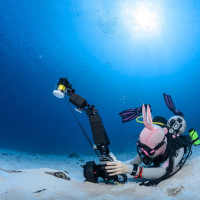SEARCH






|
|
|
|


Interview led by Editor David H Yang
Published the 26th of May 2020
This is an unique photo!
The colours and ambiance of the underwater scene are very beautiful, and create a dreamy effect.
Jennifer Lu was so kind to answer a view questions to have a better insight on how this image was made.
Where and how exactly did you shoot this, and what was done to get the final result?
Location is Kona big island of Hawaii. It was a sunset manta dive, we dropped down at the bottom of ocean which is shallow only 40 feet below surface after sunset.
A little information about this dive site : This place was voted one of the top five night dive sites in the world . Kona is home to a population of around 250 rays, because bright dive lights attract plankton in the water at night, and the swarming plankton makes an excellent free meal for these hungry rays.
Our divemasters placed a crate of dive lights on the sandy bottom that we refer to as the “campfire”. Divers drop to the bottom and sit around the “fire” and wait for plankton & mantas.
It was really looking like if you were in a show room as only spectator. Divers wear small white LED tank lights for safety. We all needed to put more pounds of weight for this dive in order to make you stay at the bottom, but if you still have trouble sticking to the bottom the divemaster gives you a rock to hold on. It was not easy for me to hold the rock in one hand while taking pictures with my other hand. I tried to stay flat at the bottom with my camera on the ground and waited for the right moment to shoot. Our bottom time is only 45 minutes. During the first 15 minutes NO mantas appeared and then the current picked up and I had to fight it. Not too long fortunately, because five big manta rays arrived. I was very excited to see the way they were dancing around. This was my third time on this location and the first time I took my camera. I knew already how the site was looking and was waiting to take a closer shot.
How was your mood while shooting?
I nearly felt like a human being and much more being part of them when I was there admiring them. I totally lost myself. It's another world ! It's hard to describe my emotions. They were so beautiful with the blue water and amazing light, It was truly like a dream galaxy to me, much stronger then I ever could have dreamed. When they were coming really close and gently flipped above me, I was holding my breath in ecstasy and didn't thing at all about taking any photos, simply enjoying the tremendous connection moment with them.
What equipment did you use to achieve this picture?
Nikon D850 , 8-15mm lens
What does it take to become an underwater photographer?
To be an underwater photographer, first you need to be a good diver. Everything is moving underwater just as if you are biking and taking pictures at the same time. It's quite challenging actually. I am a certified Dive -master since 2017, that took me over half year training in cold California ocean. I never thought about taking underwater photos because of the heavy equipment . I just bought a GoPro with me and started my "diving the whole world" plan. After diving in several countries like Malaysia, Red Sea, Palau, Indonesia, Komodo island, Bali … I realized that going pro was not enough for recording my journeys. So I got my real professional underwater camera and gear in April 2018. More work and learning how to shoot... My learning process started than while travelling to different countries to shoot different animals I was interested in. To capture certain animals you have to go special places. The great white shark for instance, is only to be seen in Cape Town and Guadalupa bay Mexico. For Tiger sharks, only to the Bahamas Tiger beach. For several other animals I had to travel to the Philippines, Manila or Bali or Indonesia, and so on...
What programs did you use to edit and process the final product?
ACR for some basic adjustments and Photoshop for some spot removing, brightness tools etc.
Thank you very much, Jennifer! Congratulations on capturing this beautiful picture!
 | Write |
 | Chao Feng 天馬 PRO Thank you and congratulations, Jennifer! |
 | Yvette Depaepe CREW Most interesting read, Jennifer! My best compliments and thanks for your fine collaboration, dear friend. Cheers, Yvette |
 | Jennifer Lu PRO Thank you so much. |